- Canon EF-S 17-55mm f/2.8 IS USM
- Canon EF-S 18-55mm f/3.5-5.6 USM
- Canon EF-S 17-85mm f/4-5.6 IS USM
- Tamron SP AF 17-50mm f/2.8 XR LD
Three new Tamron lens samples were tested. - Sigma 18-50mm f/2.8 EX DC Macro
Lens Specifications





Review of Canon EF-S 17-55mm f/2.8
IS, EF-S 17-85mm f/4.0-5.6 IS,
Tamron 17-50mm f/2.8 XR LD and Sigma
18-50mm f/2.8 DC Macro
and Canon EF-S 18-55mm f/3.5-5.6
This is a review on compact lenses for use with Canon APS-C cameras
(e.g., EOS 20D, EOS 400D Digital Rebel XTi) for general and portrait
photography. I have been using a Canon EF-S 17-85mm on a Canon 20D since
2004 and have been reasonably satisfied with its performance within its
f/4 to f/5.6 aperture limits. I wanted to see if newer f/2.8 aperture
lenses in the 18-50mm range from Canon, Tamron and Sigma would offer
substantial advantages in performance.
Lenses
Tested
Lens Specifications |
 |
 |
 |
 |
 |
50% MTF and Resolution Tests
Overall, each lens tested offered very good to excellent performance in 50% MTF and resolution tests over the 18 to 50mm focal length settings. Resolution performance was at or above 65 line pairs per mm in the target at all focal lengths with one exception. The lowest performer was the Tamron 17-50mm f/2.8. It had the lowest resolution at 50mm and low microcontrast performance at 18mm, 35mm and 50mm settings. This lower performance by the Tamron shows in the 50mm portrait test below. The Canon EF-S 17-85mm gave very good performance in its limited aperture range.
Portrait Function Test with Mannequin
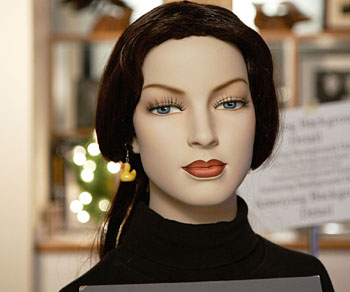 |
Portrait
Test with Mannequin Lenses were tested at 50mm for sharpness, bokeh and out of focus aperture diaphragm patterns. Lenses tested with a Canon Digital Rebel XTi:
Lighting and image processing: Shot at night with tungsten modeling light bounced off angled ceiling. RAW images processed with Capture One Pro v. 3.7.6. Additional unsharp mask, curves, brightness and contrast adjustment in Photoshop. Thumbnail images on this page are full frame. |
| Tamron and Sigma lenses were shot from the same tripod
location as the other 50mm lenses and have a wider field of view.
Therefore, focal length of the Tamron and Sigma lenses at this working
distance appears to be closer to 47 or 48 mm, rather than 50mm. Conclusion from Mannequin tests: One of the major reasons for me to own a f/2.8 lens aperture lens in the 18-50mm range on an APS-C camera is to use it for portrait photography at 50mm. I was looking for sharp images and good bokeh that would rival those produced by a 50mm prime lens. I printed the images produced in this mannequin test at 8x10 inch and 12x14 inch enlargements. After looking at the web jpg's and the prints, it was no contest. The images/prints produced by the EF-S 17-55mm f/2.8 IS and the primes "pop out" with sharpness and contrast compared at f/2.8 to those produced with the other zoom lenses. For other portrait application considerations, see: Portrait lens tests for canon APS-C cameras . |
|
Performance at 17mm or 18mm with a Parking Garage Target - Assessment of image edge sharpness and linear distortion
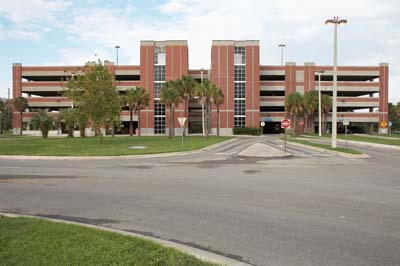 |
|
Performance at 35mm - Landscape
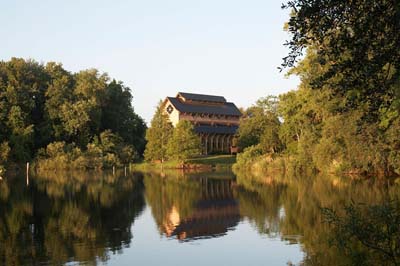 |
All lenses at f/8 produce an 11 x 17 inch print that looks about the same on the wall. The cheap Canon EF-S 18-55mm has noticeably softer edges if you look closely at a print. The expensive Canon EF-S 17-55mm lens produces slightly sharper image edges if you look closely with your nose 30cm from the print. An EF 24-105mm L image is included at the same focal length setting and f/8. |
Performance at 85mm - Landscape Detail
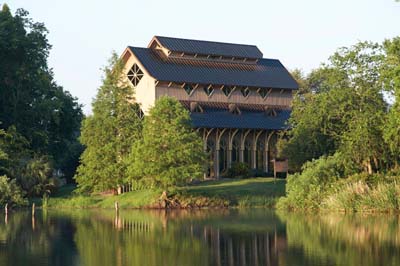 |
Sorry, only the EF-S 17-85mm lens will get this image unless you want to get in a boat with your EF-S 17-55mm IS. Included are images produced with an EF 85mm f/1.8 at f/8 and an EF 70-300mm f/4.5-5.6 DO IS at an 85mm setting. The prime gives a slightly sharper image than that produced by the EF-S 17-85 @ 85mm. However, the 11 x 17 inch print produced with the 17-85 looks very good. The DO lens has noticeably lower sharpness and contrast that shows in the print. |
Vignetting
Lenses were tested
at infinity focus using a led illuminated light box with double opaque
white diffusion screens. All lenses were tested at largest and smallest
focal length and at 35mm. Click on lenses below to assess results.
The EF-S 17-85mm f/3.5-5.6 IS and EF-S 18-55 f/3.5-5.6 show significant vignetting at all apertures to f/8. All of the f/2.8 aperture lenses showed mild vignetting that is corrected by stopping the lenses down 1 or 2 stops. The Sigma 18-50mm f/2.8 Macro showed the least amount of vignetting. |
 |
Linear Distortion: Want Less?
Check
out the lines and curves for each focal length. The EF-S 17-55mm f/2.8 IS
has the least distortion. The wider-zoom EF-S 17-85mm f/4-5.6 has the
most.
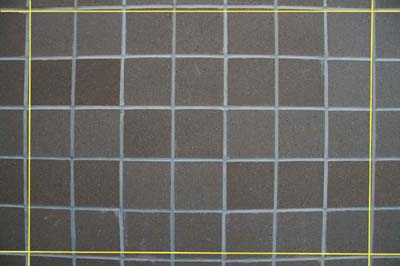 |
Corner Image Sharpness and Lateral Chromatic
Aberration
Corners of Resolution Test Charts are shown
at widest aperture and stopped down 1 to 2 stops.
|
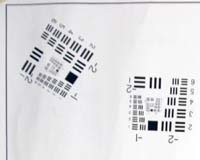 |
Flare and Internal Relections
Lenses
were tested at 50mm with a snooted monolight flash in the background
exposing the back of the mannequin at f/4. Click on lenses below to assess
results.
All of the f/2.8 aperture APS-C lenses flared under the test conditions. The Canon EF-S 17-55mm f/2.8 IS controlled flare\ internal reflections best. The Sigma 18-50mm f/2.8 Macro had the worst flare/internal reflections. |
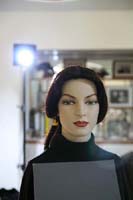 |
Autofocus Accuracy Under Variable Ambient Light
Lenses
were tested at 50mm under tungsten modeling light at 1 meter working
distance. Each lens was focused at infinity and then refocused on the
right mannequin eye and the shutter released. The test was repeated 20
times for each lens, and the percentage of in focus images were recorded.
The tests were run under good modeling lighting (ISO 800, 1/100th sec @
f/2.8) and low light conditions (ISO 800, 1/40th sec @ f/2.8). When
autofocus problems were identified under low light conditions. The tests
were repeated.
 |
|
Conclusions and Opinions
CanonEF-S 17-55mm f/2.8 IS USM
Strengths: You get
what you pay for with respect to image quality with this lens. The EF-S
17-55mm f/2.8 IS had 50% MTF and resolution scores closest to L-lenses or
primes across the focal lengths tested. There was significantly less
distortion at wide angles with the EF-S 17-55 than with all of the other
lenses tested. Edge and corner sharpness delivered by this lens in large
prints was noticeably the best of the lenses tested. Center sharpness and
contrast had the best "punch" of the lenses tested. Bokeh
produced by the lens at 50mm f/2.8 was close to the quality of that
produced by the EF 24-70mm f/2.8L at the same focal length. The 17-55 was
more resistant to flare than other f/2.8 lenses tested. Image
stabilization is very useful for low light photography. Canon has built a
lense with L performance in a relatively light and compact package.
Potential
weaknesses: It has none that are photographically significant. This is
the largest and heaviest of the APS-C f/2.8 lenses tested. Although the
17-55 has performance characteristics similar to an L-lens, weight has
been kept low at least in part by not making a sealed, weather and dust
impervious lens.
Tamron SP AF 17-50mm f/2.8 XR LD
Strengths: It was
the smallest and lightest of the APS-C f/2.8 lenses tested. I considered
the size and ergonomics of the lens on an EOS 400D Digital Rebel to be
ideal. This lens produces sharp images if stopped down to f/5.6 or f/8.
Image quality is better than that produced with the cheap kit EF-S 18-55
f/3.5-5.6 lens. Many will find the image quality produced by the Tamron
17-50 to be acceptable for portrait photographs at f/2.8. It shows good
flare resistance and produces sharp corner images when stopped down.
Weaknesses:
This lens had the lowest 50% MTF and resolution performance when used
at f/2.8. I did not find the image quality at 50mm f/2.8 adequate to shoot
portraits for even moderate enlargement (e.g., 8x10 inches). It has poor
low light autofocusing performance on a Canon camera (EOS 400D Digital
Rebel XTi). The autofocus motor on this lens is very noisy.
Tamron
has quality control problems. The first lens I received did not autofocus
properly and was exchanged for a functional lens with the dealer. If I
added my time and extra shipping expenses to the price of the lens, it
yielded an unfavorable performance/cost ratio. I was concerned that I may
have had two bad lens samples, so I
purchased a third new lens to test. It gave comparable 50%
MTF and resolution performance to the first two lenses. The Tamron lens
has uniformly low performance compared to the other lenses tested at
f/2.8.
Sigma 18-50mm f/2.8 EX DC Macro
Strengths: This lens
generally had better center-weighted performance on 50% MTF and resolution
tests than the Tamron. Autofocus was fast and quiet, and vignetting was
least of the lenses tested. Although it had slightly worse flare
performance than the Tamron, all of the lenses tested in this review
flared less than my EF 50mm f/1.4 prime.
Weaknesses: Although
the Sigma 18-50 was sharper for portrait use than the Tamron, you could
see significant differences in print sharpness between it and the Canon
17-55. Sigma has built a very good lens that gives excellent performance
in center weighted images. Far corner performance on the Sigma was the
worst of the lenses tested. In low light, the lens underperforms in
accuracy against the cheapest Canon lens used in this test.
Canon EF-S 17-85mm f/4-5.6 IS USM
Strengths: Within
it's aperture limits, the EF-S 17-85 is an incredibly versatile lens that
offers excellent performance in a compact, light weight package. The
17-85mm range (28-135mm full frame equivalent) is excellent for travel and
general photography when you can only carry one lens. It has generally
excellent performance shot wide open. Image stabilization is excellent and
will save the day in low light situations. I have been very happy with the
infrared photos taken with this lens on a converted 20D (see gallery).
Weaknesses:
Shooting portraits without good background selection is challenging when
the widest aperture in the 50-85mm range is f/5.6. The lens has greater
linear distortion than the other zooms tested. This lens wouldn't be your
first choice for use in architectural photography.
Canon EF-S 18-55mm f/3.5-5.6 USM
I included this ultra-cheap
kit zoom in the tests assuming it would perform poorly. I was pleasantly
surprised.
Strengths: It is an ultralight, very compact lens
that gives good performance when stopped down to f/5.6 or f/8. It
performed better in low light autofocus accuracy tests than either the
f/2.8 Sigma or Tamron. Distortion isn't any worse than with the Tamron and
Sigma zooms.
Weaknesses: Softness is apparent in image corner
and edges in large prints. This lens is good for snapshots. You'd want to
use another lens for most photographs you want to enlarge to any great
extent.
Gallery of EF-S 17-85mm f/4-5.6 IS USM Images
Sigma 18-50mm f/2.8 EX DC Macro Photos from Test
Canon EF-S 17-55mm f/2.8 IS Photos from Test
Index
Posted
28 May 2007; Latest revision posted 30 August 2007
©
2007, William L. Castleman